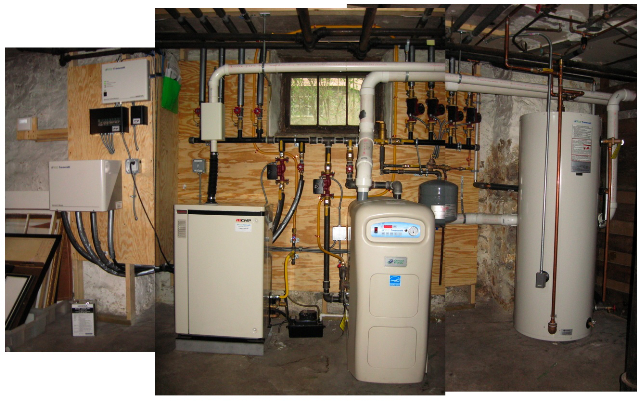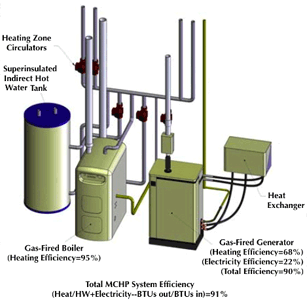There’s a monster in our basement. It eats fistfuls of dollar bills, guzzles No. 2 heating oil, and belches filthy clouds of soot and CO2. We have to kill it before it kills us. Only problem is, we and our tenants are dependent on it — this being New England, we need something down there to keep us from freezing our butts off when winter rolls around again.
 Nothing to fear but furnace itself.Ever since my partner Edith and I bought our 100-year-old Boston triple-decker two years ago, we’ve been plotting the demise of its beastly old, big-as-a-refrigerator, criminally inefficient, oil-fired boiler. Now we’ve found an unexpected solution, and it’s taking shape right under the gluttonous old fiend’s outstretched cast iron pipes. We’re replacing our monster with a state-of-the-art, super-efficient micro-combined heat and power system.
Nothing to fear but furnace itself.Ever since my partner Edith and I bought our 100-year-old Boston triple-decker two years ago, we’ve been plotting the demise of its beastly old, big-as-a-refrigerator, criminally inefficient, oil-fired boiler. Now we’ve found an unexpected solution, and it’s taking shape right under the gluttonous old fiend’s outstretched cast iron pipes. We’re replacing our monster with a state-of-the-art, super-efficient micro-combined heat and power system.
Huh?
Combined heat and power — or cogeneration, as it’s also known — captures the waste heat from generating electricity to heat a building. Thomas Edison himself thought it up in the late 1800s, but only now, in the face of 21st century energy challenges, is it starting to catch on for small-scale use. Ours is one of the first 80 or so residential MCHP units to be installed in the entire country. And it should cut both our total annual energy cost and our carbon footprint by roughly half.
Looking for Heat in All the Wrong Places
We knew when we started househunting that we’d almost certainly have to invest in a significant energy upgrade. Homes in the U.S. use roughly 20 percent of the country’s energy and produce roughly the same share of carbon emissions; and a huge amount of that — as much as 60 percent by some estimations — is wasted. Older homes tend to be especially inefficient, and the one we ended up buying was no exception.
 The old beast in the basement.Peter Thomson
The old beast in the basement.Peter Thomson
In many ways, our modest urban three-family is a paragon of efficient resource use, built to accommodate a lot of people comfortably on a very small patch of land. But energy-wise, the house and its heating system remain relics of a distant era. By the time we first crossed its threshold, heating oil was heading toward $4 a gallon and atmospheric CO2 toward 400 parts per million. We knew the consequences were potentially catastrophic, for us and the planet.
But we also knew we’d have to be patient — we were putting down a mountain of cash on the house, and it would be a while before we could make another big investment.
And despite its faults, our boiler was a little like my dad: still lumbering along in relatively fine shape even after eight decades or so. The thing may not have been designed for efficiency, but it sure was built to last.
So we started with the low-hanging energy-saving fruit: we caulked cracks, installed low-flow water fixtures, swapped our incandescents for CFLs, and added insulation (incredibly, after 100 New England winters, our house was still wearing the equivalent of a spring jacket).
These improvements helped curb the monster’s appetite, but the beast was still not broken. So we started researching alternatives.
We began with grand visions of the big three renewables: solar, wind, and geothermal.
Alas, while our research revealed exciting advances in those areas, none were yet a good fit for our property or budget, so we resigned ourselves to making a more conventional swap — from our ancient, no-better-than-65-percent-efficient oil guzzler to a decorous modern, 95 percent natural gas sipper.
That swap alone would bring a huge savings, in money, energy, and carbon. Gas is cheaper and has more energy per unit of mass, and burning it produces nearly 30 percent less CO2. And switching from a heating and hot water system that wastes at least 35 percent of its energy would mean a huge boost in efficiency.
But we also knew that the electric grid we draw our power from is an even bigger hog per unit of energy than our ancient boiler. We were eager to tamp down its appetite as well, if only by a tiny fraction, and willing to invest a bit more up front to make that happen. And just as we thought we were out of options, a new one came into view.
As a journalist covering the environment and energy, I’d first caught sight of micro-cogeneration maybe fifteen years ago — a blip on the far edge of the radar screen. “Someday soon,” everyone had said, and there it sat, like nuclear fusion or cellulosic ethanol, a promising energy breakthrough, always just out of reach. But now, here were the EPA and the Sierra Club and even Popular Mechanics suddenly extolling the benefits of micro-CHP, and there was an actual brochure, for an actual product, from an actual company — which, it turned out, was just a few towns away. We picked up the phone.
Watts, Happening Now
The company was called Climate Energy, a joint venture between a little local engineering firm and the big national heating equipment manufacturer ECR International. After seven years of R&D, they’d just brought their first product to market: the Freewatt system, which pairs a 95 percent efficiency gas heating unit with a small, 1.2 kilowatt, gas-fired Honda generator.
 Honda’s generator: a model for the future?HondaHere’s how it works, in a nutshell: When a home needs heat or hot water, the first part of the system to fire is not the furnace but the generator. It burns gas to produce electricity, and also produces an unavoidable byproduct, waste heat. But instead of venting that heat, the MCHP unit uses heat exchangers to capture some of it and pump it into the heating system. Then, if the demand for heat exceeds what the generator can provide, the furnace itself kicks in. The electricity, meanwhile, is either used in the house or fed back onto the grid. Together, the system produces heat, hot water, and electricity at more than 90 percent efficiency. That’s 10 percent better than even the highest-efficiency boiler paired with a comparable amount of electricity from the grid, and more than 50 percent better than our current system.
Honda’s generator: a model for the future?HondaHere’s how it works, in a nutshell: When a home needs heat or hot water, the first part of the system to fire is not the furnace but the generator. It burns gas to produce electricity, and also produces an unavoidable byproduct, waste heat. But instead of venting that heat, the MCHP unit uses heat exchangers to capture some of it and pump it into the heating system. Then, if the demand for heat exceeds what the generator can provide, the furnace itself kicks in. The electricity, meanwhile, is either used in the house or fed back onto the grid. Together, the system produces heat, hot water, and electricity at more than 90 percent efficiency. That’s 10 percent better than even the highest-efficiency boiler paired with a comparable amount of electricity from the grid, and more than 50 percent better than our current system.
This first Freewatt system was built around a hot-air furnace, which is what heats most houses in the U.S., but — damn! — not ours. But the company promised to have a forced hot water system available soon. If we were willing to take the leap of faith that goes along with being early adopters, we could soon be among the first in the country to embrace this long-promised technology.
We loved the idea. We were also terrified. This would be a very expensive experiment.
We set out to do a direct comparison of the ten-year costs of each system. The upfront expense was easy; including some major replumbing that we’d have to do for either system, a conventional high-efficiency gas system would cost us roughly $20,000, while the MCHP would cost us about $23,500, about 15 percent more.
Running the longer-term numbers, though, was another story. It turns out that the array of variables involved in comparing the cost and efficiency of heating and hot water systems is mind-boggling. Roll in the added complexity of switching fuels, generating some of our own electricity, and trying to calculate carbon emissions, and it was almost enough to send us running to the basement to give our dependable, uncomplicated old monster a bottle of Geritol and a winter-long hug.
After weeks of research and calculations, we finally arrived at a rough bottom line: either system would likely save us at least $3,000 a year in fuel while improving our overall efficiency by more than 30 percent, and cutting our carbon emissions by more than 40 percent, or almost nine tons. But the Freewatt would reduce our emissions by roughly another two tons a year. It would also save us at least $500 a year on electricity, which meant we could pay off the difference between the two systems in about seven years.
We took a deep breath, crossed our fingers, and took the leap.
Leap, and the CHP Will Appear
And now, there it is, a sleek array of white boxes, tubes, pumps, valves and pipes, settling in next to our fuming, red-faced monster and climbing the granite walls of our foundation. Soon, the Freewatt system will be hooked into the plumbing, and our house will have made a 100-year leap into the future. Our friends and neighbors are already lining up to come over and see it.
 The shiny new system, installed (see a labeled version of this photo here).Peter ThomsonWe still don’t know exactly how this leap will pay off, given all the variables, including things completely out of our control, like how cold next winter is, and how well our tenants manage their heat. We don’t know how well the technology itself will work, or even how the new company that designed it will fare. We’re going out on a limb here, and there’s a small chance it could fall out from under us.
The shiny new system, installed (see a labeled version of this photo here).Peter ThomsonWe still don’t know exactly how this leap will pay off, given all the variables, including things completely out of our control, like how cold next winter is, and how well our tenants manage their heat. We don’t know how well the technology itself will work, or even how the new company that designed it will fare. We’re going out on a limb here, and there’s a small chance it could fall out from under us.
But we know that if the U.S. is going to make the huge changes required on energy consumption and carbon emissions, some people are going to have to go out on limbs, try new technologies and start to seed the market. Without early adopters there’ll be no massive transformation.
We’re willing to take the risk. And we’re fairly certain our gamble will mean we’ll even save money in the long run. We’re slaying our own little monster, and hopefully helping give birth to something that will help us all slay a much bigger one.




